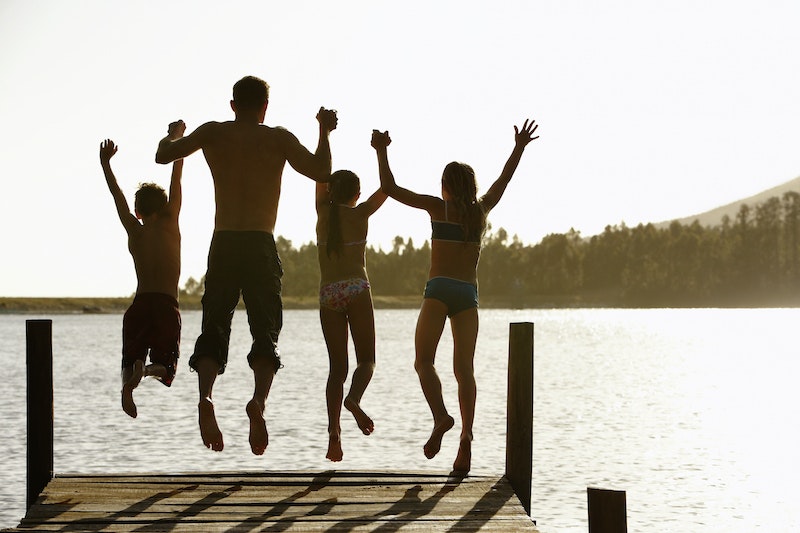Longer days and warmer temps can be the perfect backdrop for summer adventures and more time outdoors. And being outside is great for reducing stress, getting exercise, and improving mood. But summer also has a specific set of safety rules to keep in mind –– including some that are urban legends. Before you shake off spring and head toward the beach or block party, take a minute to sort fact from fiction.
Myth 1: The higher a sunscreen’s SPF, the longer you can go before reapplying
Mythbuster: The number on the front of that sunscreen bottle has nothing to do with how long it lasts. The sun protection factor (or SPF) is a measure of how much it will protect your skin. For instance, SPF 15 means it protects the skin from 93% of UVB radiation, while an SPF 30 protects the skin from 97% of those dangerous rays. (Notice that a higher SPF doesn’t double the protection, but it does increase it.)
But no matter which SPF level you buy, you’ll still need to reapply at least every two hours, or sooner if you’ve been swimming or sweating a lot from the heat or activity. Consider setting an alarm, so you don’t have to watch the clock — or fear a sunburn.
Myth 2: To remove a tick, reach for matches or nail polish
Mythbuster: If a tick is embedded in your skin, trying to burn it or suffocate it is definitely not the answer, says Jean Tsao, PhD, a professor in the department of fisheries and wildlife at Michigan State University and co-creator of the tick-tracking app the Tick App.
Instead, use a pair of fine-tipped tweezers and grab onto the tick as close to the skin as possible, pulling it out with even pressure. Using fire puts you at risk of burning yourself, and trying to smother it with petroleum jelly or nail polish only leaves the tick in longer — when what you want is to get it out asap, says Tsao.
To better avoid getting bitten in the first place, she suggests spraying or soaking your clothes, shoes, and socks with a repellent made with the chemical permethrin, as well as using DEET or other EPA-approved repellents. You can also stick to the middle of trails when you hike and wear light-colored clothes, which make the bugs easier to spot.
Myth 3: Set up your BBQ in the shade, and any fixin’s should be fine for a few hours
Mythbuster: Shade has nothing to do with food safety; the temperature of the air around it does. So a picnic table full of lingering potato salad, deviled eggs, pasta salad, and cheeses could be a serious danger to diners.
According to the FDA, potential food-poisoning microorganisms can thrive from 40°F to 140°F. To feast without fear, keep all perishable food in a cooler or refrigerator until serving time, and once served, don’t let it sit out for longer than two hours (if the temp is above 90°F, stick to an hour or less). After that, stash food back in the fridge or cooler. If you happen to forget and leave food out longer, consider tossing the leftovers.
Myth 4: If you don’t squint in the sun, there’s no need for sunglasses
Mythbuster: Just as unprotected skin can be damaged by the sun, unprotected eyes (specifically, the cornea) can get sunburned, says Michelle Andreoli, MD, clinical spokesperson for the American Academy of Ophthalmology.
Photokeratitis, the medical name for the condition, is a pretty rare occurrence, she says, but there are plenty of other reasons to cover your peepers. People who live in sunny climates or who participate in sun-soaked sports like surfing are more susceptible to a condition called pterygium, which is when the clear tissue that lines the eyeball starts to thicken and overgrow onto the pupil.
Chronic sun exposure has also been linked to macular degeneration and skin cancer (melanoma) of the eye, says Andreoli. “I tell my patients to wear sunglasses when they’re outside, even when it’s cloudy,” she says.
Myth 5: After a meal, wait 30 minutes before you get back in the water
Mythbuster: Digestion does draw some blood away from muscles and other parts of the stomach to aid in the breakdown and transport of food, but not enough to cause your arms or legs to function less than they would an hour or two hours after a meal.
There’s simply no research to support the claim that swimming right after eating will cause severe cramps. Despite rumors of official warnings, we found no warnings or guidelines –– from the American Academy of Pediatrics, American Red Cross, or other organization –– related to swimming after eating.
One time that waiting is worthwhile is during a summer thunderstorm. The National Oceanic and Atmospheric Administration advises waiting at least 30 minutes from the last lightning crack to get back in the water, to avoid the risk of being struck by lightning.
AMY WILKINSON
Rally Health





